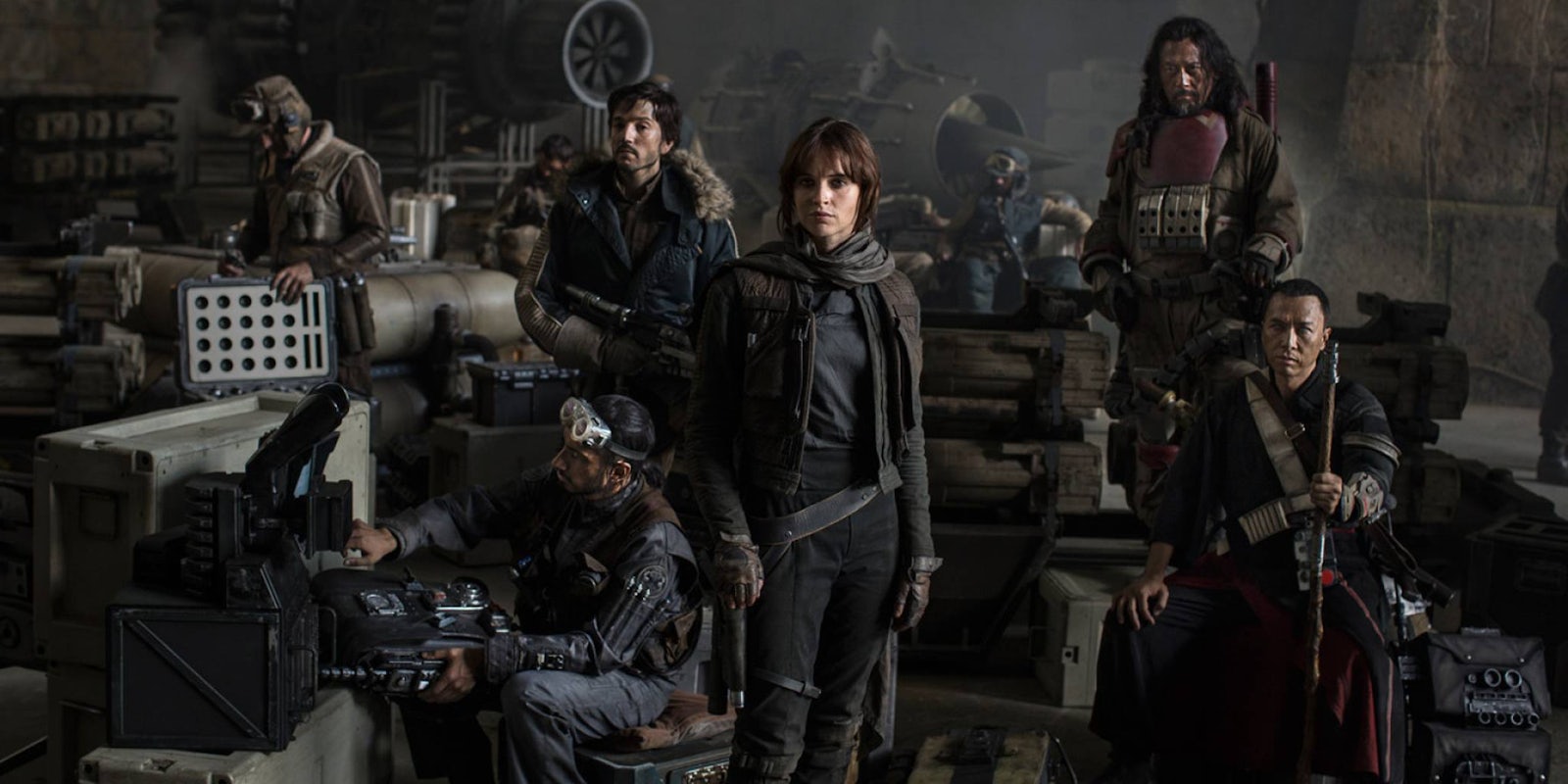To watch the Rogue One teaser trailer is to see the future. Specifically, it’s to see that day, not far off, when R2-D2 hacks into Iron Man’s armor and Groot has a long conversation with Chewbacca. “Groot? “Rowwwwwr!” “Groot!”
Yes, it’s true, the trailer is supposedly set long, long ago, and neither Iron Man, R2-D2, Groot or Chewie, appear in it. Instead, for the most part, the teaser is pretty anonymous. There are Star Wars trappings—the bad guys who get shot and blown up are wearing storm trooper outfits, and of course there’s the John Williams score, rearranged but still insistently recognizable.
But beyond such branding touches, Rogue One: A Star Wars Story could be any big budget Hollywood action story. Jyn Erso (Felicity Jones) is a typical raffish disreputable troublemaker turned likely-unlikely hero in the Han Solo/Rocket Raccoon/James Bond spirit—the fact that she’s a woman is a twist, but (thanks Linda Hamilton!) not unprecedented. She shoots things, she blows things up, someone mutters some portentous narration, evil cloaked figures stand around and look ominous.
It could be Independence Day; it could be Mission Impossible. It could be a superhero film. Superhero films love the ominous cloaked guys.
The genericness is the point—and the genius.
Rogue One, in short, looks, not just like any Star Wars film, but like any franchise film. When Felicity Jones strides purposefully across the screen, she could be striding through any Hollywood set, towards any McContrived McGuffin. It’s not just generic, it’s generically generic, uber-generic, and meta-generic. The genericness is the point—and the genius.
In the dim, dark, past, when people carved their computers out of stone blocks and every other film didn’t feature superheroes, franchises used to mean something, you young whippersnappers. If you went to a Star Wars film, you could be sure that the film featured Harrison Ford, or at least Obi-Wan Kenobi, and was (or at least was trying to be) part of a single overarching narrative about a galaxy far, far away. Superman films were about Superman doing superstuff, even when (as in Superman IV) the superstuff didn’t make a lot of sense. Star Trek had familiar actors as familiar characters going where no one had gone before. And so forth. A franchise didn’t just mean, hey, okay, we’re calling this Star Trek, buy tickets, Trekkie. It meant you were going to get the characters, the actors, the themes you were expecting, delivered more or less competently to your expectant eyeballs. Franchises: You could trust them.
The Marvel Cinematic Universe changed all that, though.
Superhero comics long ago figured out the advantages of making franchises a kind of contentless brand; the Marvel universe encompassed the monstrous Man-Thing and the heroic Captain America at the same time, because why not cross-promote completely dissimilar things if your fans will stand for it? Similarly, the Marvel Cinematic Universe can include a comedy space opera like Guardians of the Galaxy, straight period action/adventure like the first Captain America film, and a wrenching exploration of sexual violence like the Netflix television series Jessica Jones. “Marvel” doesn’t refer to a particular story, or particular actors, or characters, or even to a consistent tone. It’s just the term “Marvel,” some crossover Easter eggs, and maybe some bad guy in a cloak. Pick any movie, say it’s part of the Marvel universe, and rake in the dough. The franchise is no longer even really a franchise. It’s a logo.
The logo-ing of the franchise is an ingenious business model—and so, inevitably, it’s being replicated.
The logo-ing of the franchise is an ingenious business model—and so, inevitably, it’s being replicated. Warner Bros. is desperately trying to catch up by dumping all its DC superhero movies into the same world, whether they be bombastic bloated epics like the (critically panned) Batman vs. Superman or jokey heist dramas like the (much anticipated) Suicide Squad. Disney is working off the same template with their Star Wars films, figuring out ways to make a whole series of stories and heroes set loosely in the same universe, setting up potential crossovers and cross-promotion.
That template virtually ensures that sometime, somewhere in the not too distant future, one of those Star Wars films is also going to be a Marvel Universe film. The whole logic of the logo model is to put the logo on as many films as you can, no matter the content of those films. So why not double up your logos, especially if you’re Disney and own both of them? Even before the rule of the logo-franchise, Dracula met Frankenstein and Predators fought Aliens. Those crossovers seemed a bit gimmicky—but these days, crossovers are film’s lifeblood. If you know Hulk and Ant-Man are going to meet at some point, why not Dr. Strange and Obi-Wan Kenobi?
Presumably the inevitable Marvel/Star Wars convergence will start with low-key, Easter egg cameos. Maybe we’ll get to see Darkseid conferring with Kylo Ren; a glimpse of Gamora across a crowded cantina; Tony Stark making some elliptical reference to hyperspace. But eventually we’ll get to full on team-ups—Drax fighting side by side with Chewbacca, or the Vision and BB-8 discussing the nature of artificial intelligence.
Nor is there any real reason it should stop there. Why not Batman vs. Terminator, or James Bond meets Tarzan, or Toy Story Die Hard? The logo franchise model opens up infinite possibilities, an exciting vision of a giant, sprawling League of Extraordinary Nostalgia Properties. All the things you love on the screen at the same time; what could be more fulfilling? Every film can be the same film—with, perhaps, the logos slightly shuffled.
Noah Berlatsky is the author of Wonder Woman: Bondage and Feminism in the Marston/Peter Comics 1941-1948 and the editor of the comics and culture blog The Hooded Utilitarian. He writes for the Guardian, Quartz, the New Republic, and numerous other outlets. Follow him on Twitter @nberlat.


